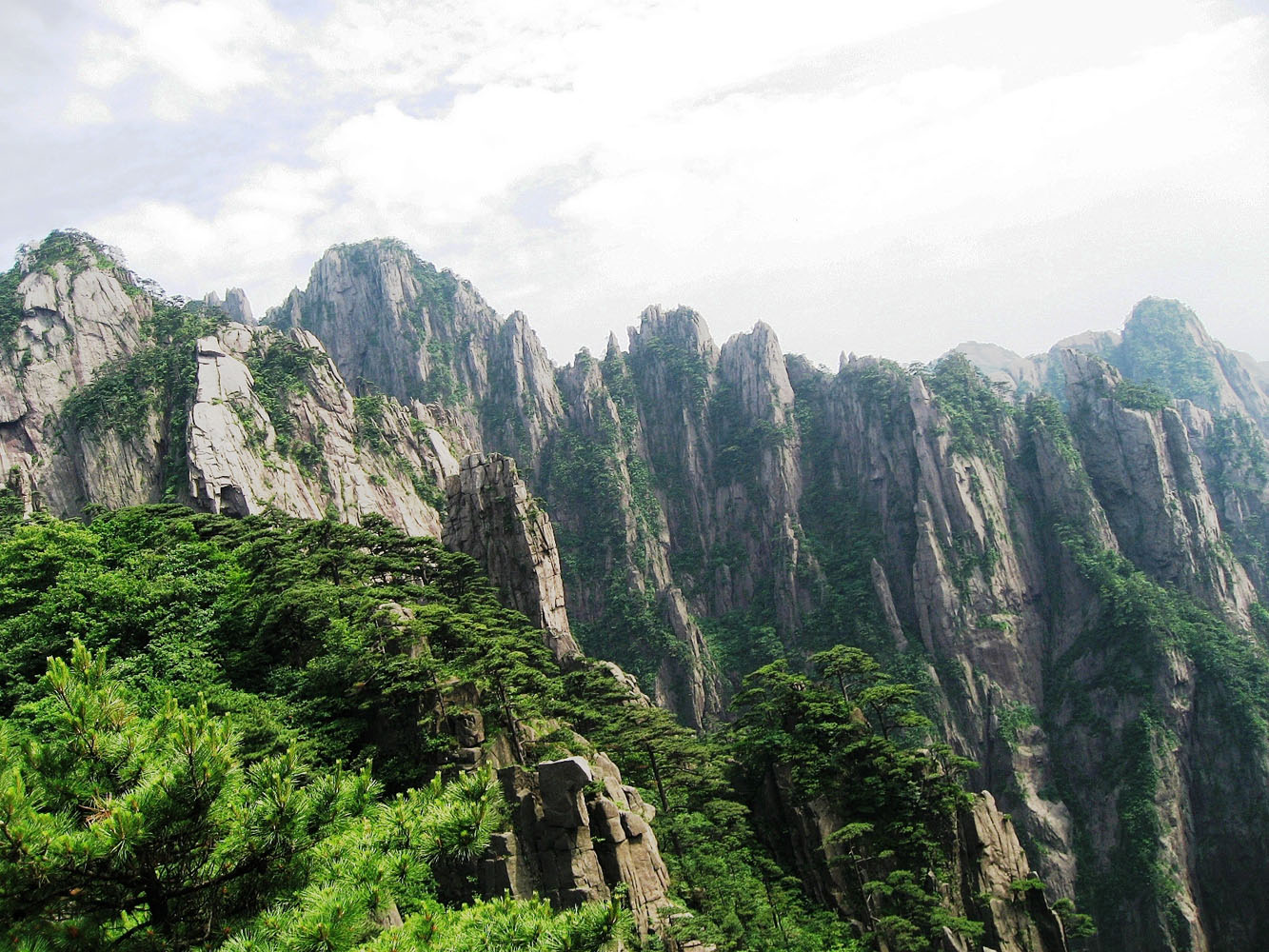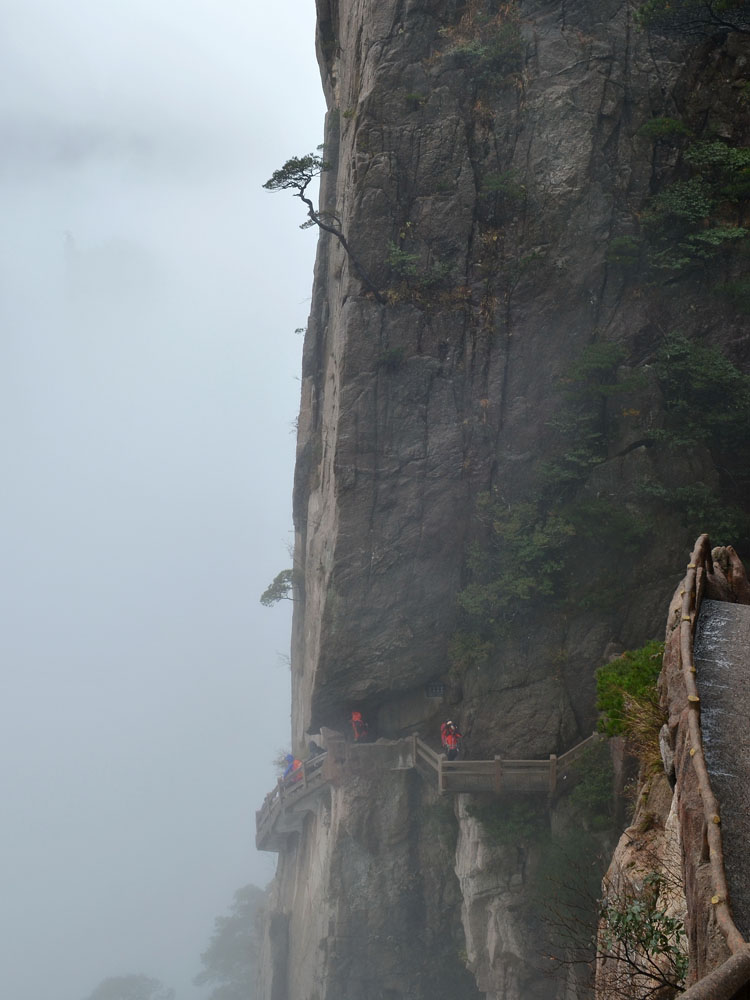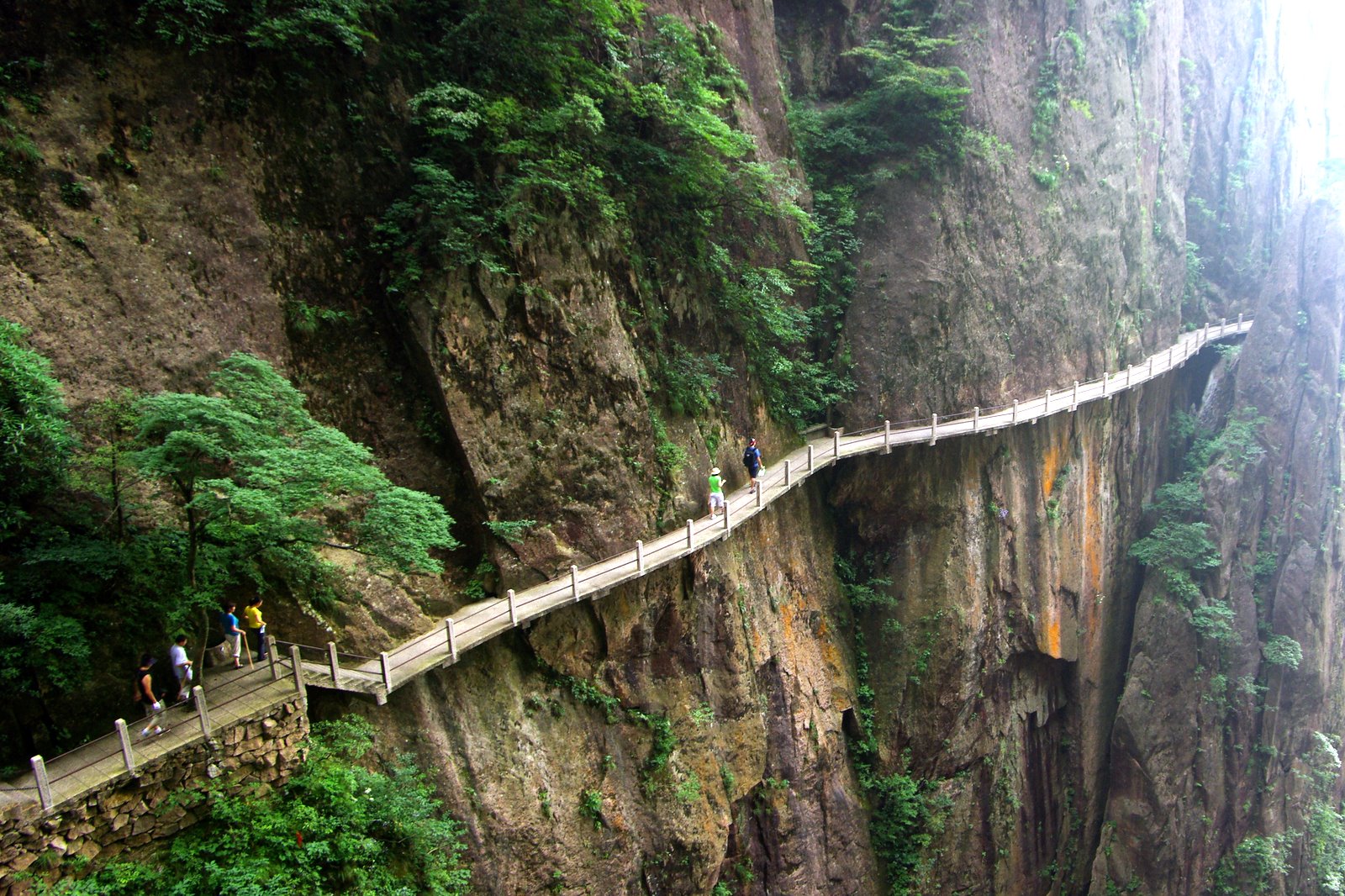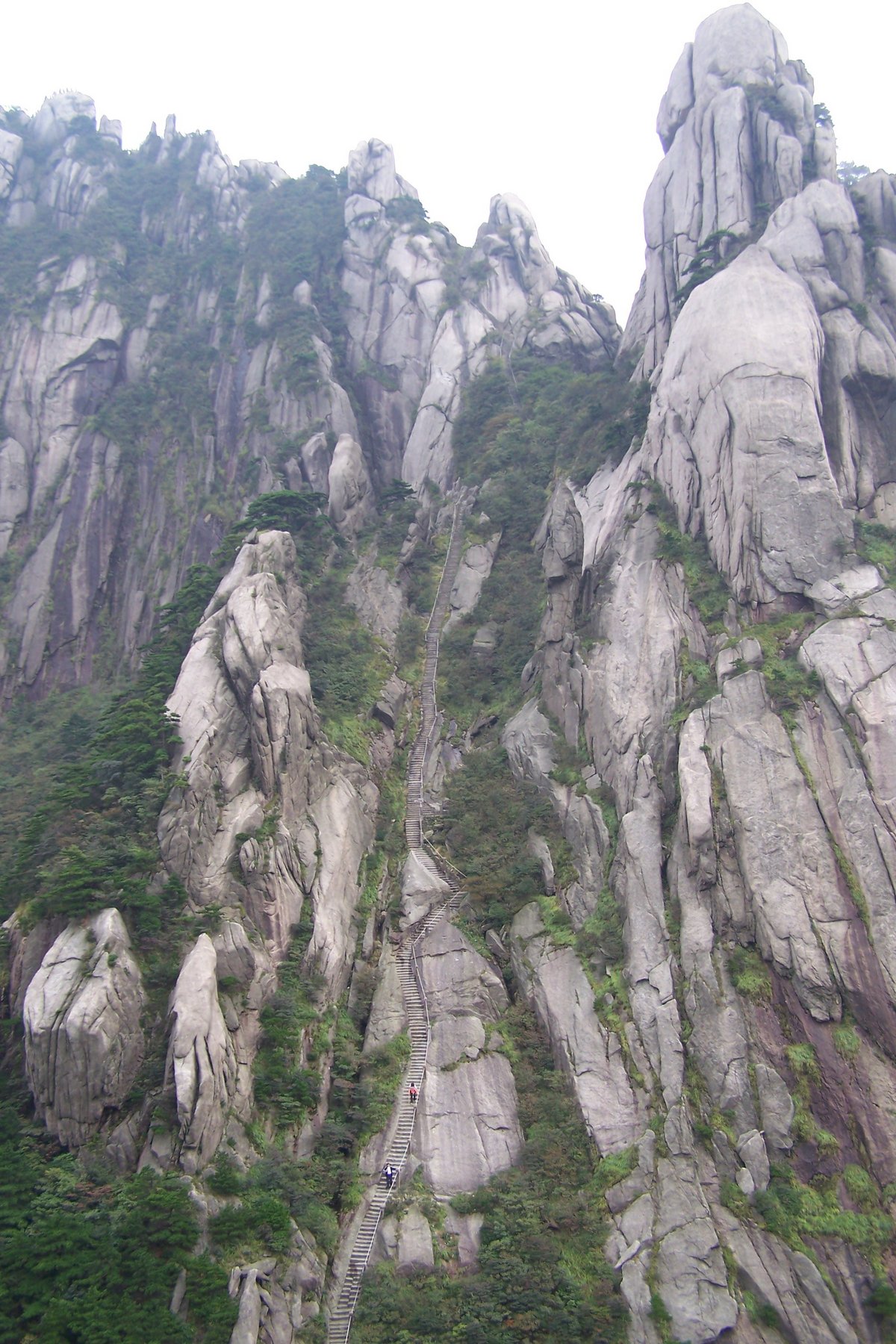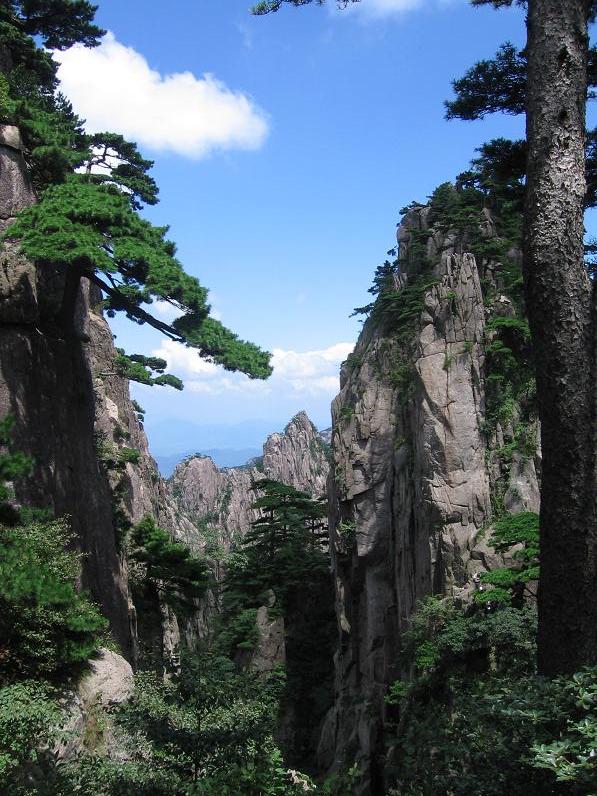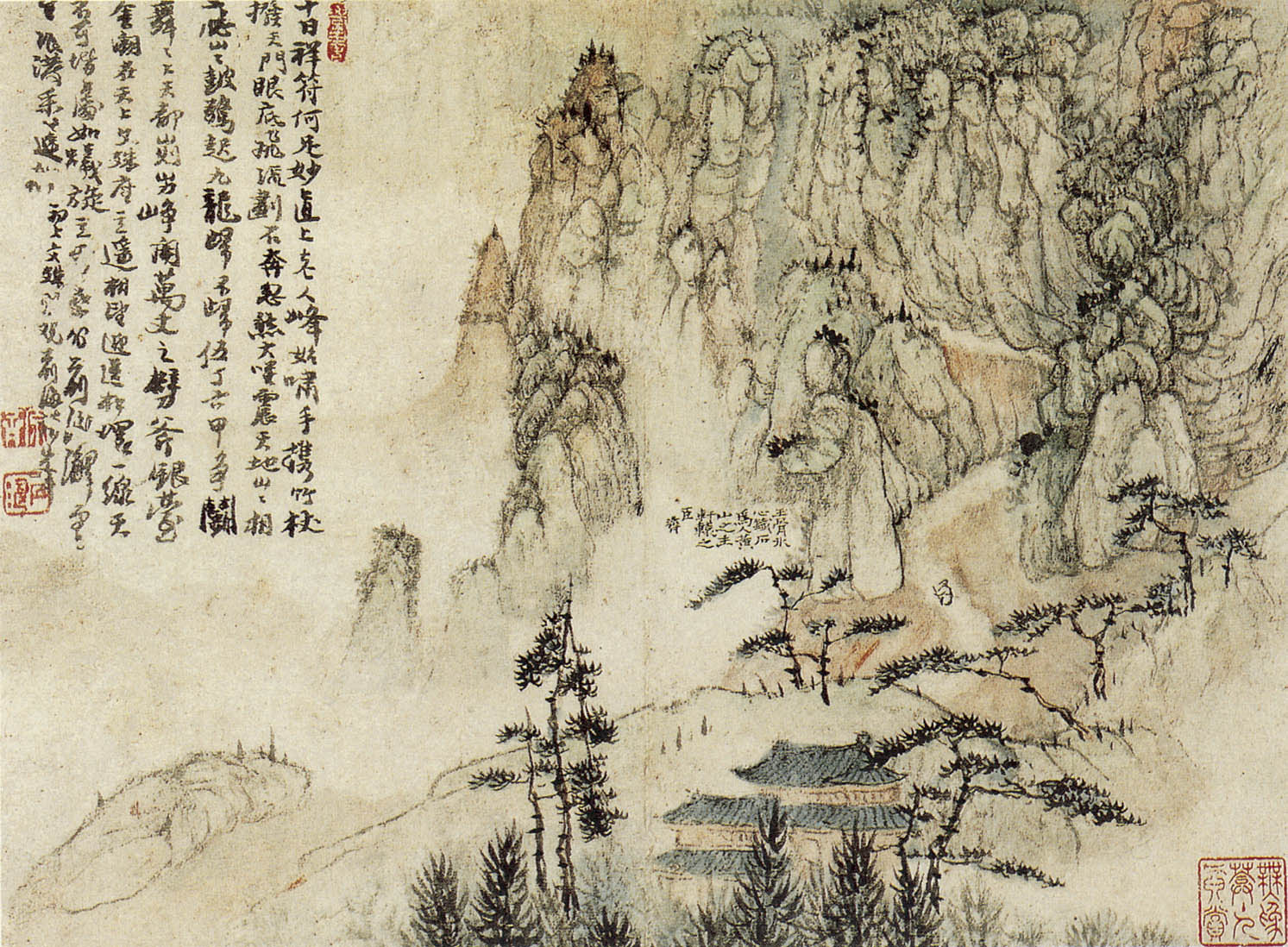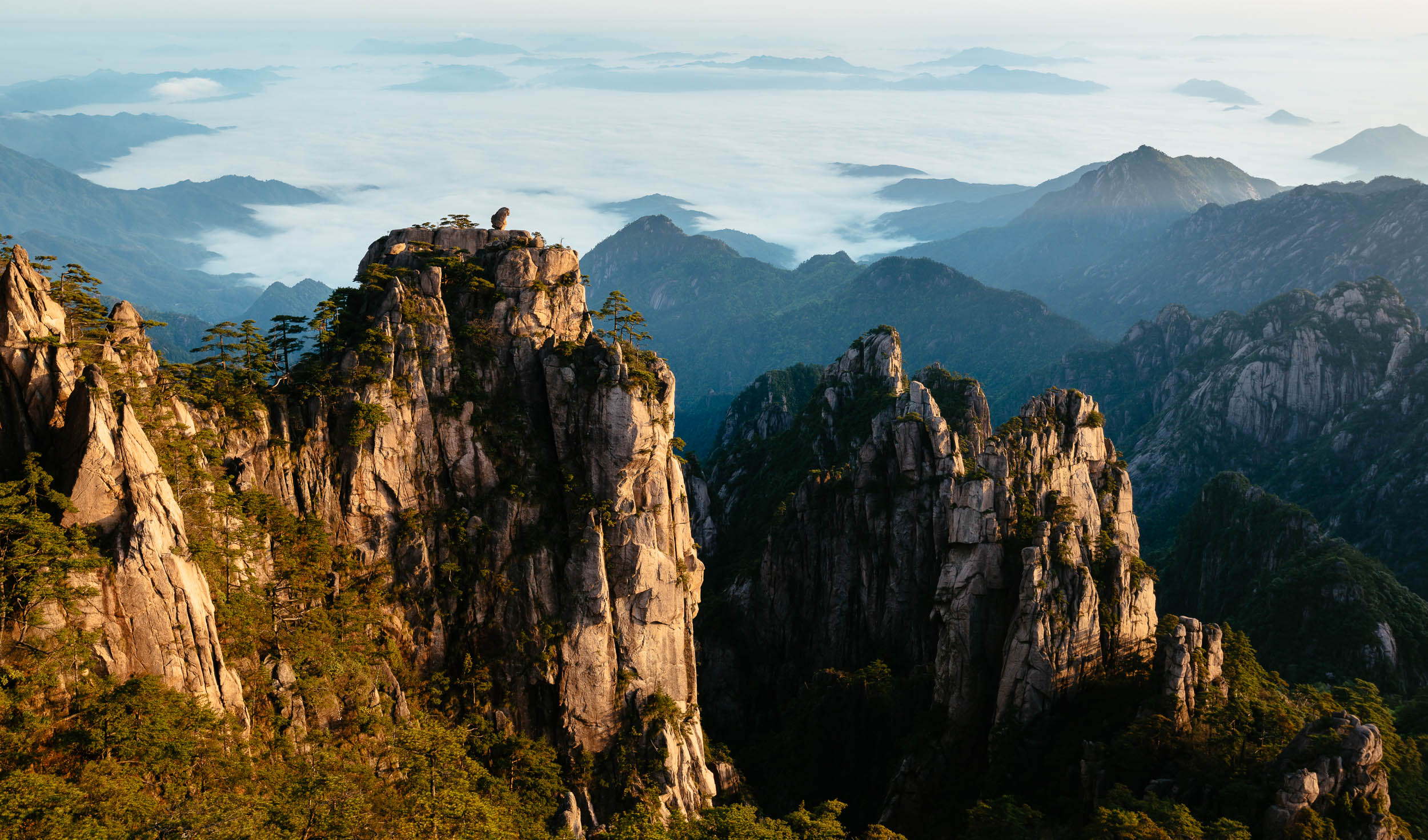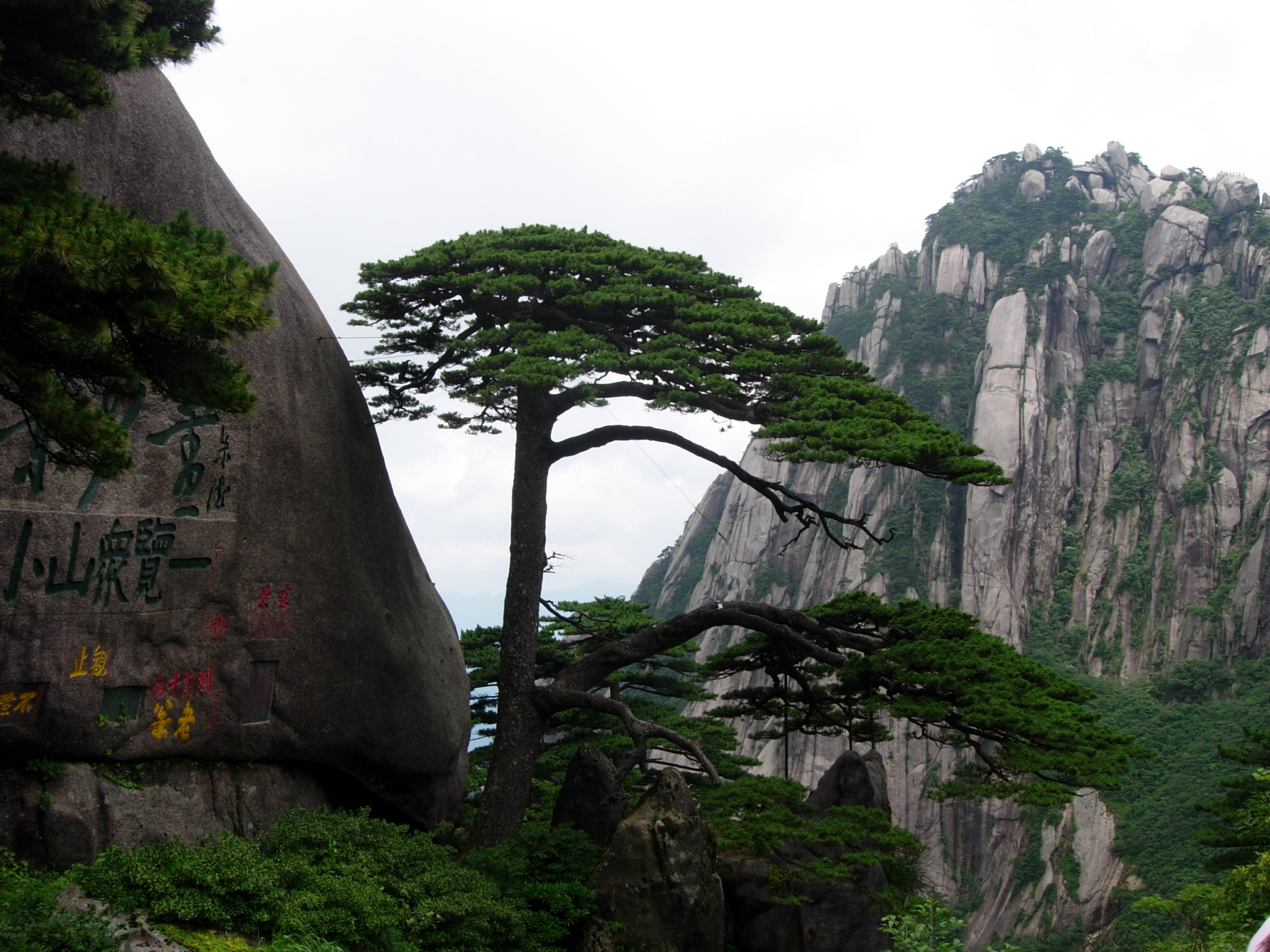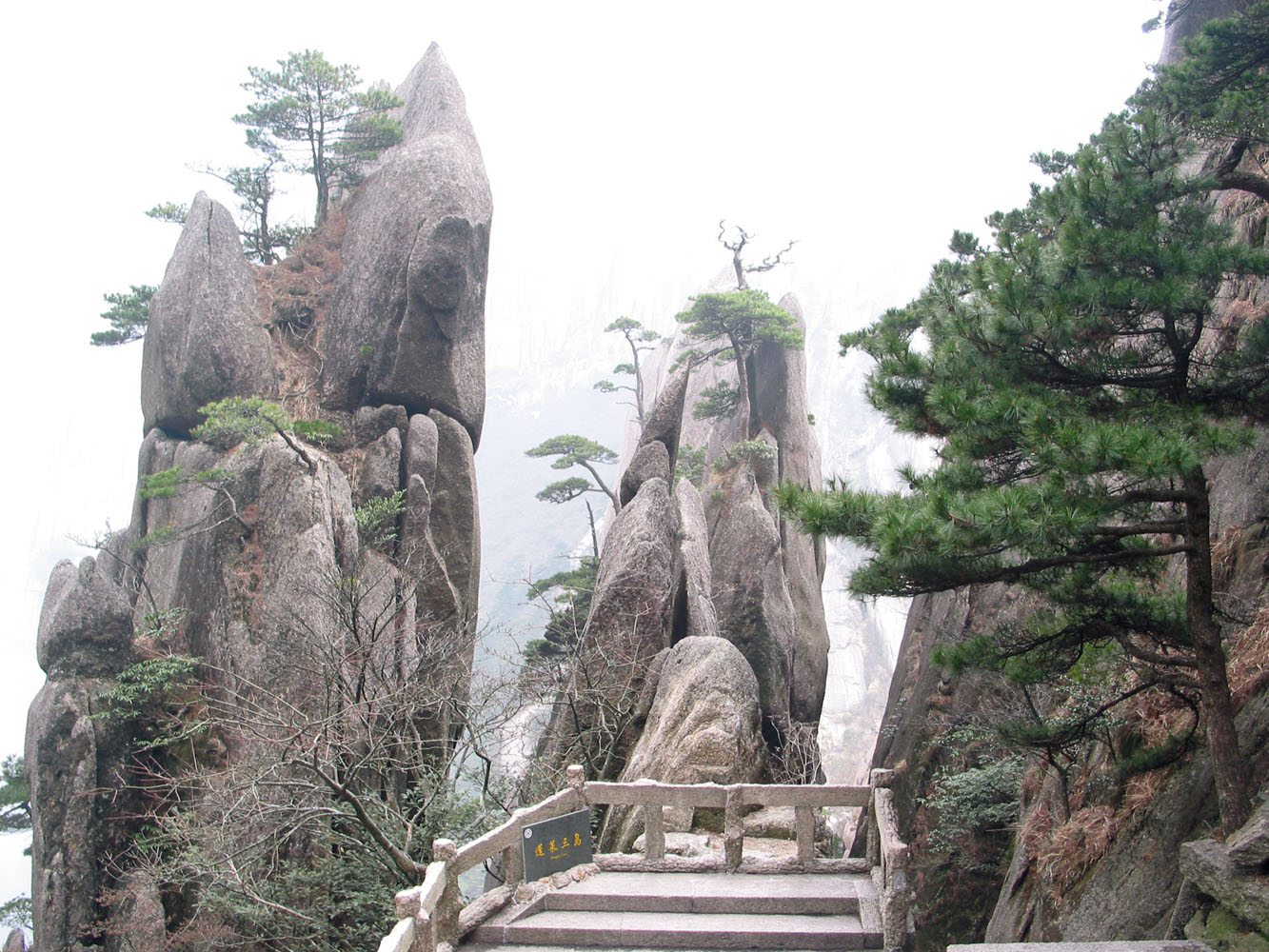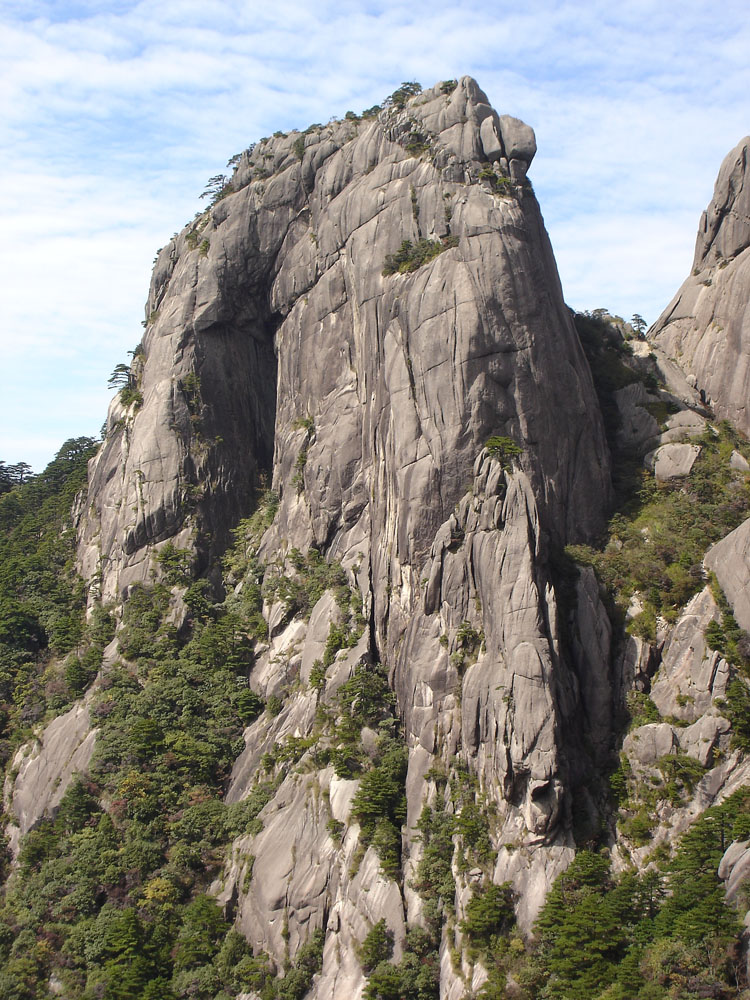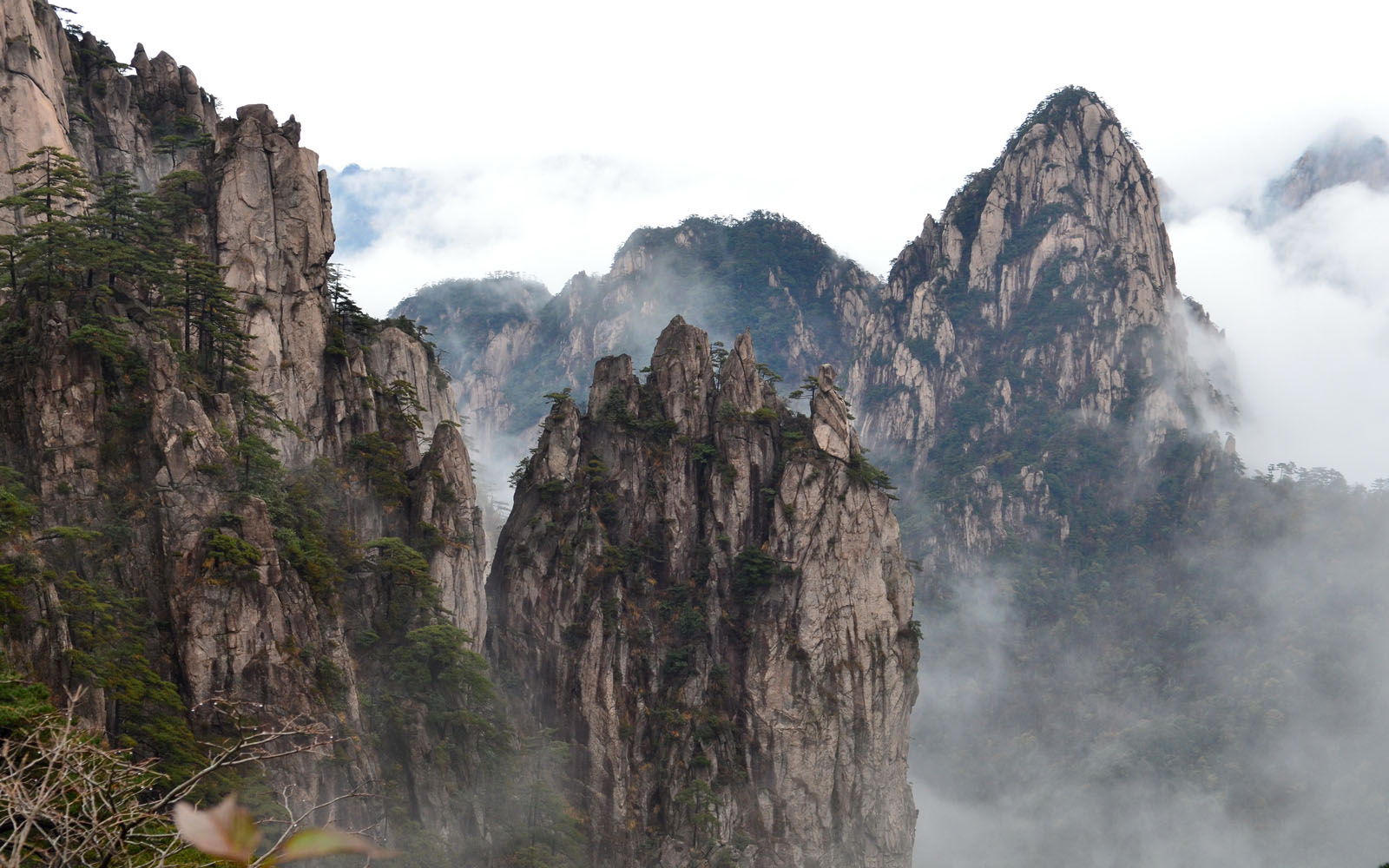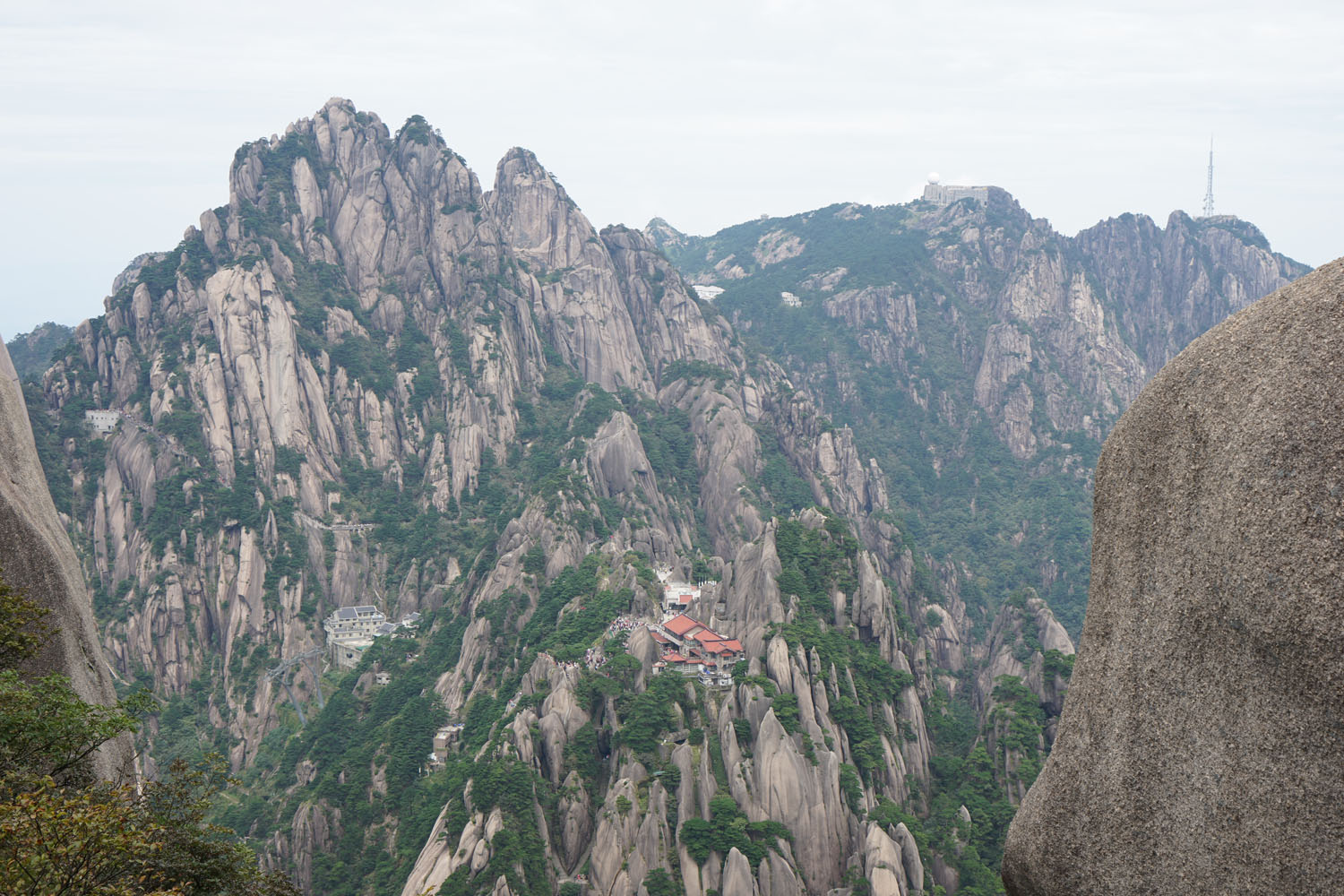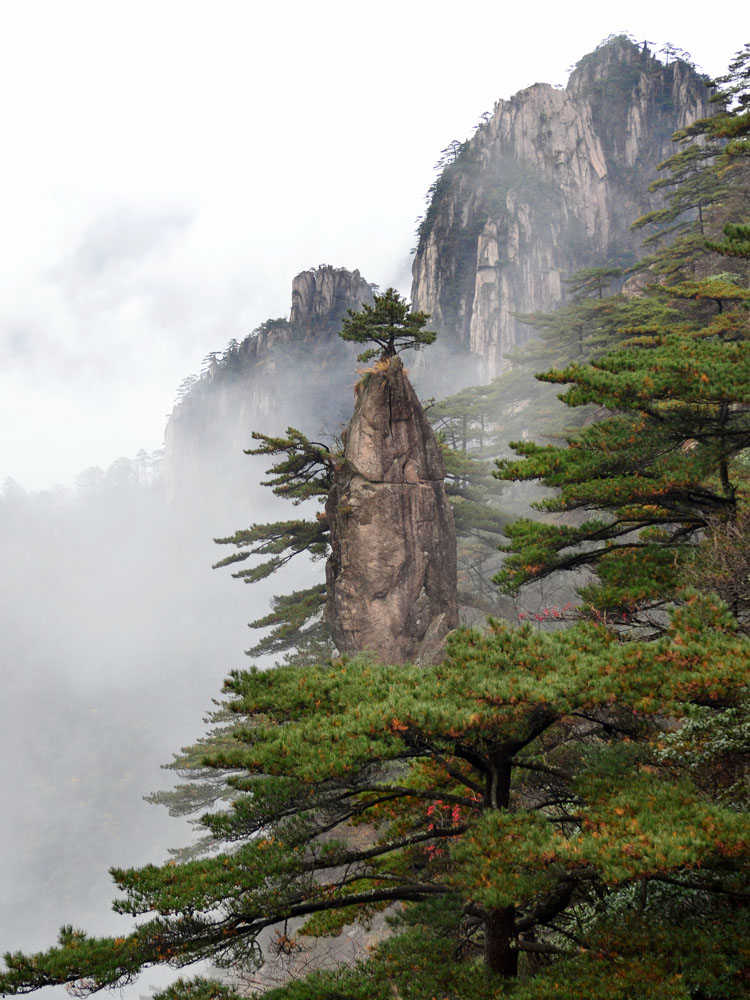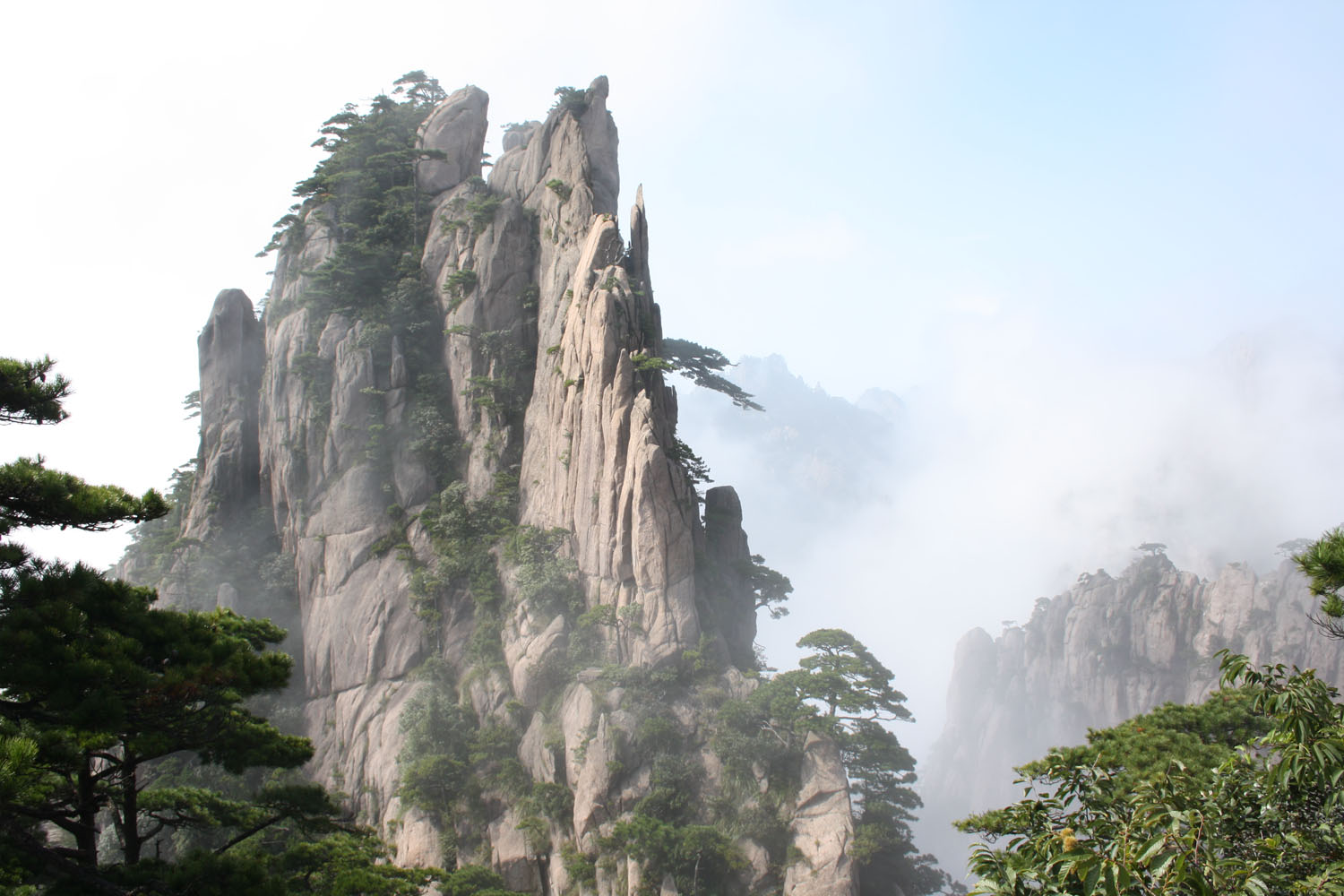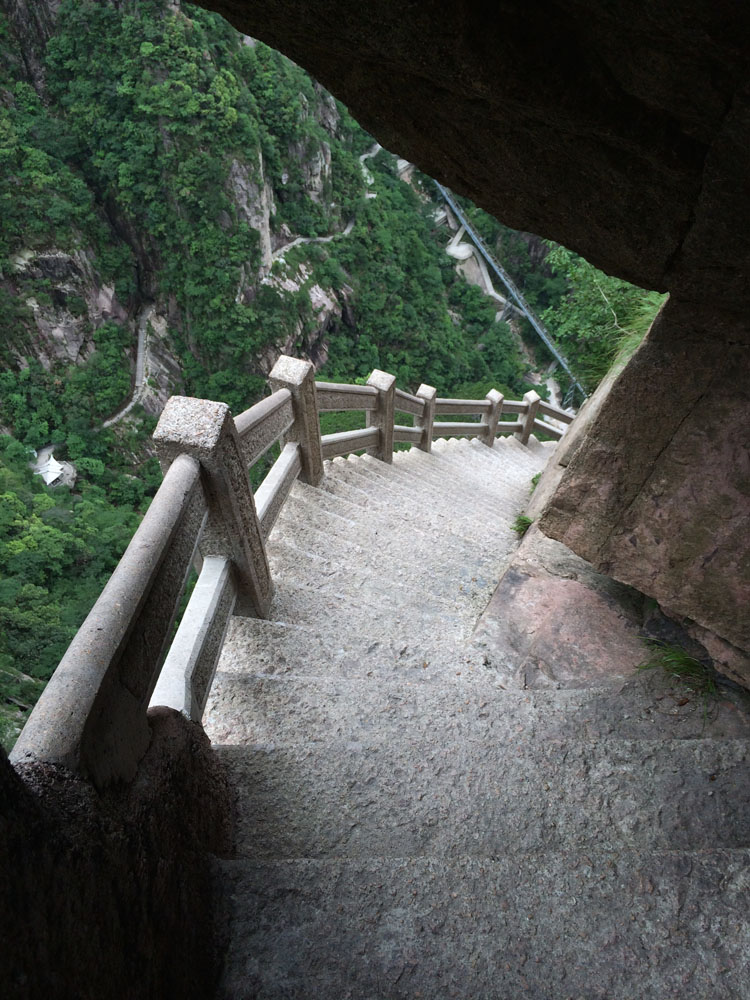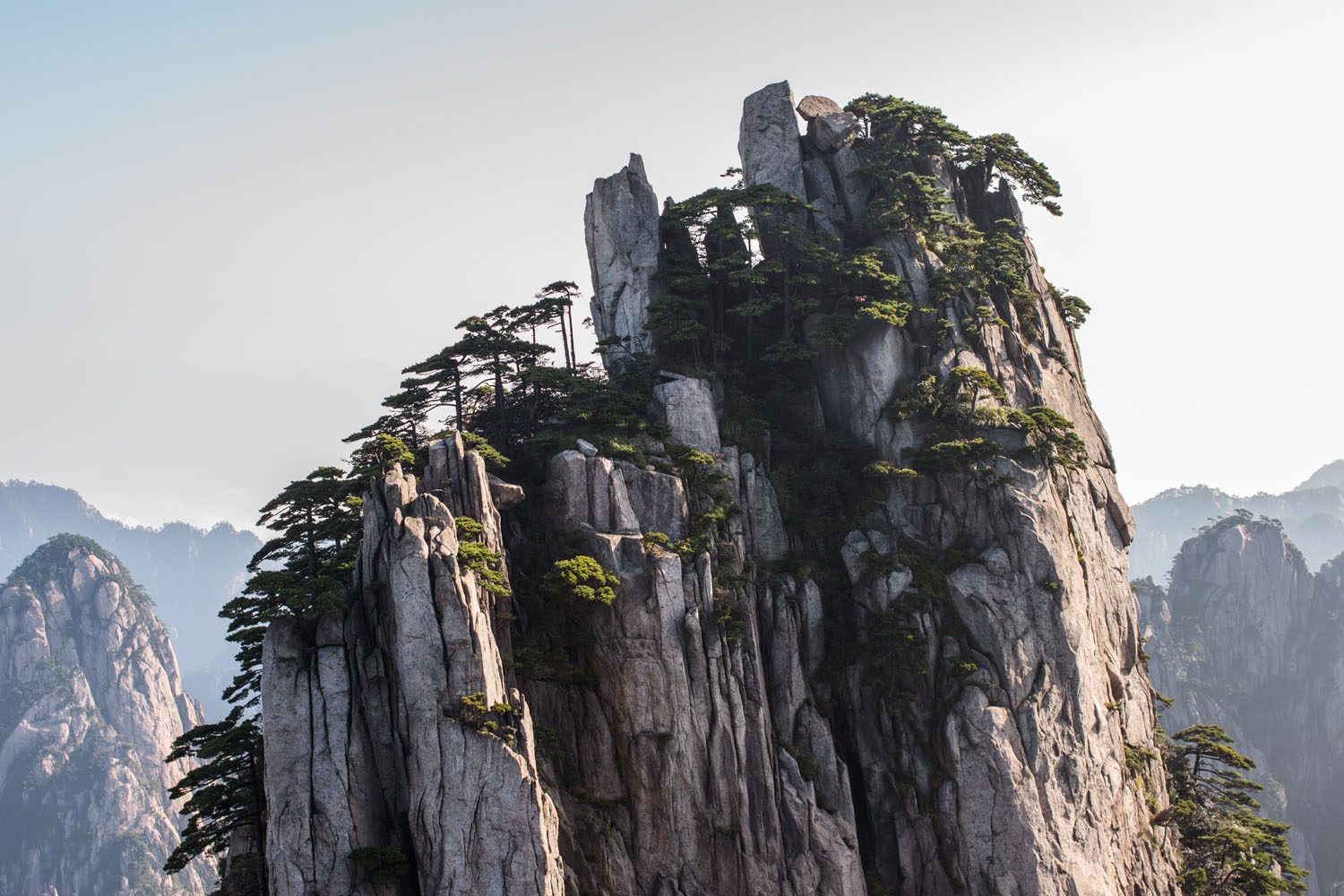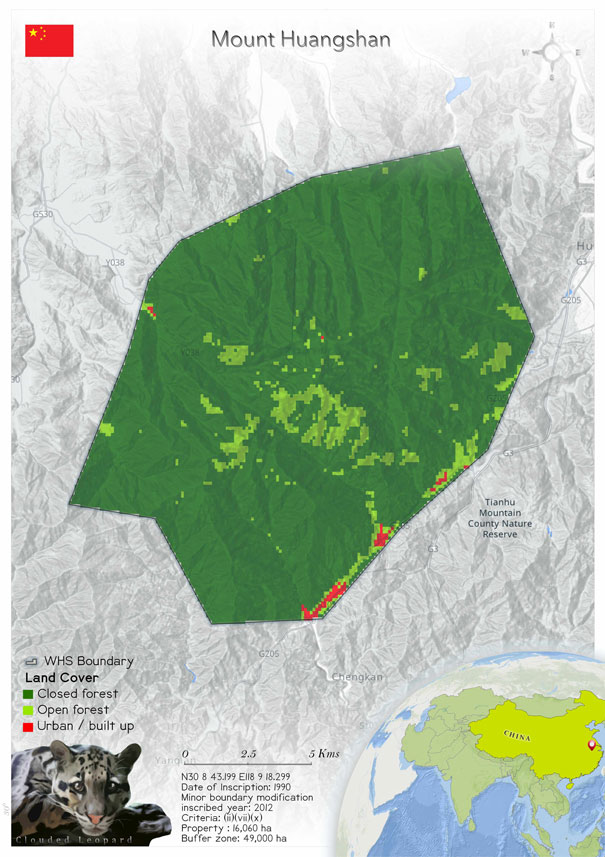
Mount Huangshan (547)
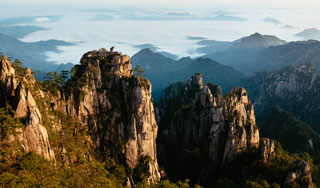 Mount Huangshan is located in the Nanling Range, in south-eastern China. It is 400 km south-west of Shanghai and has 77 mountain peaks rising upto 1000 m. These have grotesque rocks, forests of stone pillars, gnarled pines, other old trees, waterfalls, caves and hot springs, such as cinnabar hot springs. The diversity of ecosystem and topography supports a rich diversity of life. The site has been accorded the status of “the loveliest mountain in China”, thus it has drawn people searching for natural experiences. This has led to the establishment of sustainable tourism and attracted funding for management, providing the local community assured incomes. The core area of the biosphere reserve is not inhabited though there are monks in monasteries and on mountain tops. Most of these people live with their staffs and their dependents on the tops of hills. The site acts as a reminder to the people in China of the value of preserving aesthetic, cultural and spiritual beauty and underlines ways of motivating environmental conservation. There are a large number of visitors each year. Thus there is waste and litter at the site, and the vegetation cover, flora and fauna have been affected. Mount Huangshan is also exposed to the perils of forest fires, especially during the dry season. Therefore, the authorities have taken measures to control wildfires by building fire brigades and water ponds.
Mount Huangshan is located in the Nanling Range, in south-eastern China. It is 400 km south-west of Shanghai and has 77 mountain peaks rising upto 1000 m. These have grotesque rocks, forests of stone pillars, gnarled pines, other old trees, waterfalls, caves and hot springs, such as cinnabar hot springs. The diversity of ecosystem and topography supports a rich diversity of life. The site has been accorded the status of “the loveliest mountain in China”, thus it has drawn people searching for natural experiences. This has led to the establishment of sustainable tourism and attracted funding for management, providing the local community assured incomes. The core area of the biosphere reserve is not inhabited though there are monks in monasteries and on mountain tops. Most of these people live with their staffs and their dependents on the tops of hills. The site acts as a reminder to the people in China of the value of preserving aesthetic, cultural and spiritual beauty and underlines ways of motivating environmental conservation. There are a large number of visitors each year. Thus there is waste and litter at the site, and the vegetation cover, flora and fauna have been affected. Mount Huangshan is also exposed to the perils of forest fires, especially during the dry season. Therefore, the authorities have taken measures to control wildfires by building fire brigades and water ponds.
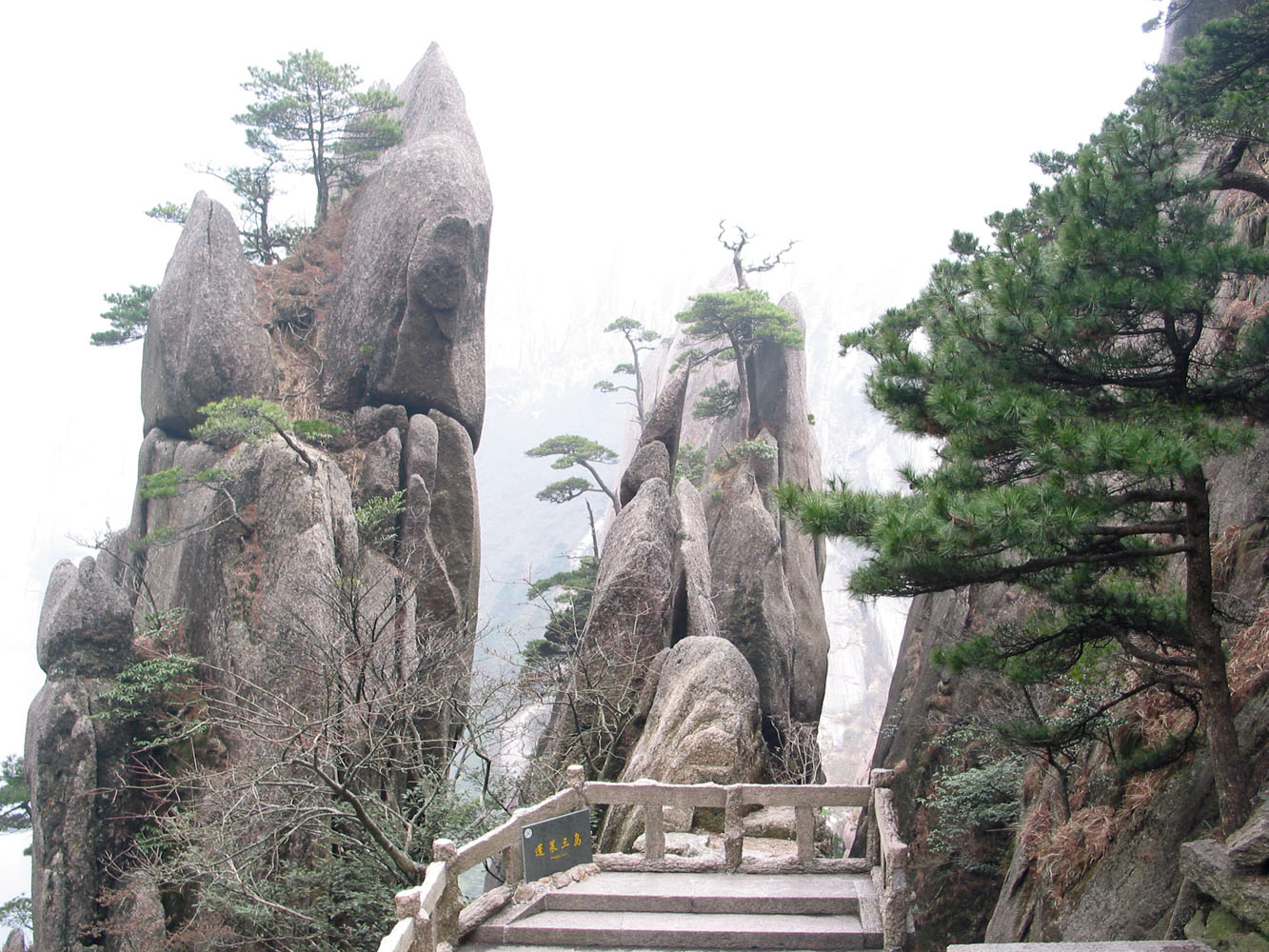 Mount Huangshan is located in the Nanling Range, in south-eastern China. It is situated 400 km south-west of Shanghai, in the southern part of Anhui Province, between latitudes 30° 01' and 31°18' N and longitudes 118° 01' and 118° 17' E. The fundamental summit incorporates Lotus Flower Peak, at 30° 10' N and 118° 11' E (World Heritage Outlook 2020). It was inscribed as a World Heritage Site in 1990. Mount Huangshan encompasses a forest ecosystem that has remained unchanged since the last glacial period. The site is acclaimed and honoured in both literature and art with, the focal point being the presence of Shanshui (mountain and water) style of painting. The biosphere reserve has been a sanctuary with diverse and ancient plant and animal species since the Quaternary glacial period. In addition, with a diverse range of floral and faunal species, the region serves as a germplasm bank and biodiversity hotspot. It also serves as a crucial water source for the Xin’An, Qing Yi and Qiupu river systems. The exclusive geological, topographical and climatic conditions have shaped the remarkable biodiversity of the site and endowed the sub-tropical granite mountain with an evergreen broad-leaved forest ecosystem. The site is an international hot spot of research on animals and plants. It has 77 mountain peaks that rise 1000 m high, 36 of which are called beauty spots. The climate type is monsoonal, explaining why the humidity is 70% throughout the year and the annual rainfall is 2395 mm. There is snowfall on an average of 158 days in a year. The property supports high biodiversity: 2385 taxa of higher plant, 417 vertebrate (38 fish, 28 amphibian, 52 reptile, 224 bird and 75 mammal) species, 138 spider species, 175 butterfly species, 19 plant species and 20 animal species found at the site are listed in the IUCN Red List. Thirtyfive of the plant species and 57 animal species included in CITES appendix. The plant species include Musci (16%), Hepaticae (13.46%) and 161 species of fern in 37 families and 66 genera (IUCN Consultation 2020). In total there are 132 families (58.2% of the families in China) with 696 genera (23.8%) and 1714 species (7%) of angiosperm (HSAC 2014). The endemic species consist of 13 species of pteridophyte and six higher plants (SoOUV, 2013). Other species include 70 mammal, 246 bird, 31 reptile, 28 amphibian and 32 fish species (Consultation with HSAC 2017; IUCN Consultation, 2020). The state has 13 species including the clouded leopard (Neofelis nebulosa) (Vulnerable) and Oriental stork (Ciconia boyciana) (EN) (SoOUV 2013). The site also has eight endemic plant species and four endemic animal species.
Mount Huangshan is located in the Nanling Range, in south-eastern China. It is situated 400 km south-west of Shanghai, in the southern part of Anhui Province, between latitudes 30° 01' and 31°18' N and longitudes 118° 01' and 118° 17' E. The fundamental summit incorporates Lotus Flower Peak, at 30° 10' N and 118° 11' E (World Heritage Outlook 2020). It was inscribed as a World Heritage Site in 1990. Mount Huangshan encompasses a forest ecosystem that has remained unchanged since the last glacial period. The site is acclaimed and honoured in both literature and art with, the focal point being the presence of Shanshui (mountain and water) style of painting. The biosphere reserve has been a sanctuary with diverse and ancient plant and animal species since the Quaternary glacial period. In addition, with a diverse range of floral and faunal species, the region serves as a germplasm bank and biodiversity hotspot. It also serves as a crucial water source for the Xin’An, Qing Yi and Qiupu river systems. The exclusive geological, topographical and climatic conditions have shaped the remarkable biodiversity of the site and endowed the sub-tropical granite mountain with an evergreen broad-leaved forest ecosystem. The site is an international hot spot of research on animals and plants. It has 77 mountain peaks that rise 1000 m high, 36 of which are called beauty spots. The climate type is monsoonal, explaining why the humidity is 70% throughout the year and the annual rainfall is 2395 mm. There is snowfall on an average of 158 days in a year. The property supports high biodiversity: 2385 taxa of higher plant, 417 vertebrate (38 fish, 28 amphibian, 52 reptile, 224 bird and 75 mammal) species, 138 spider species, 175 butterfly species, 19 plant species and 20 animal species found at the site are listed in the IUCN Red List. Thirtyfive of the plant species and 57 animal species included in CITES appendix. The plant species include Musci (16%), Hepaticae (13.46%) and 161 species of fern in 37 families and 66 genera (IUCN Consultation 2020). In total there are 132 families (58.2% of the families in China) with 696 genera (23.8%) and 1714 species (7%) of angiosperm (HSAC 2014). The endemic species consist of 13 species of pteridophyte and six higher plants (SoOUV, 2013). Other species include 70 mammal, 246 bird, 31 reptile, 28 amphibian and 32 fish species (Consultation with HSAC 2017; IUCN Consultation, 2020). The state has 13 species including the clouded leopard (Neofelis nebulosa) (Vulnerable) and Oriental stork (Ciconia boyciana) (EN) (SoOUV 2013). The site also has eight endemic plant species and four endemic animal species.
Criterion (ii)
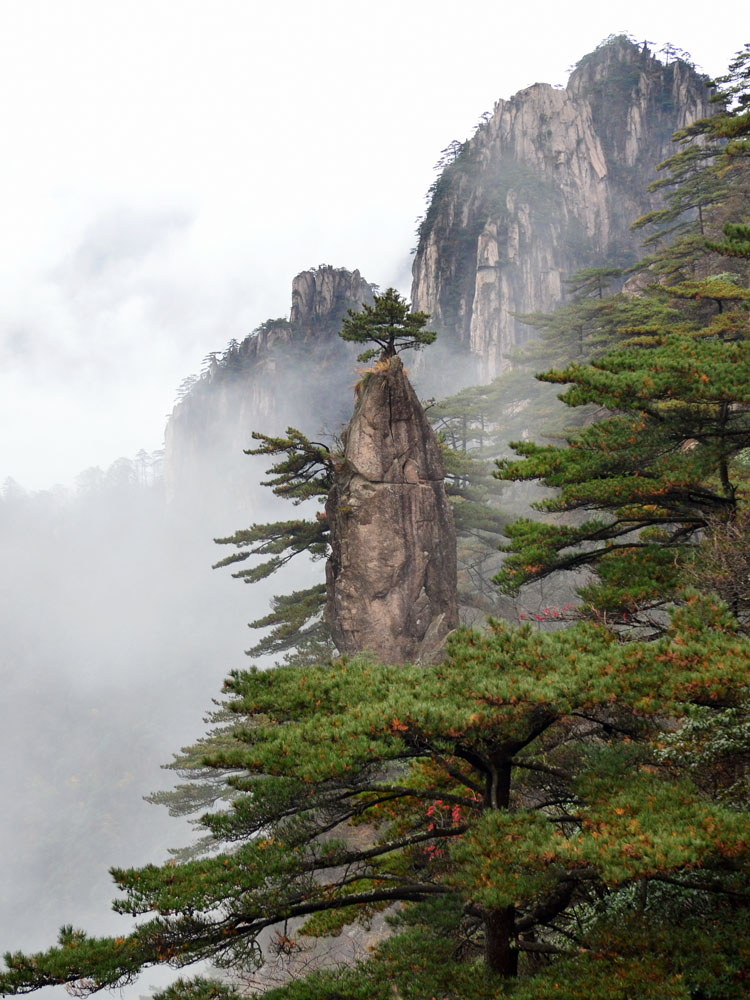 The cultural value of Mount Huangshan’s scenic landscape first entered the Chinese imagination in the Tang Dynasty and has been held in high esteem ever since. The mountain was named Huangshan (Yellow Mountain) by imperial order in the year 747 and from that time on attracted many visitors, including hermits, poets and painters, all of whom eulogized the mountain’s inspirational scenery through painting and poetry, creating a rich body of art and literature of global significance. During the Yuan Dynasty (1271-1368), 64 temples were constructed on the mountain. In 1606, the monk Pumen came to Huangshan and built the Fahai Meditation Temple. By the Ming Dynasty (around the16th century), depictions of Mount Huangshan had become a favourite theme of Chinese landscape painters, establishing the influential Shanshui (“Mountain and Water”) school of landscape painting. Showcasing the interaction of man and nature in this highly scenic setting has inspired generations of Chinese artists and writers.
The cultural value of Mount Huangshan’s scenic landscape first entered the Chinese imagination in the Tang Dynasty and has been held in high esteem ever since. The mountain was named Huangshan (Yellow Mountain) by imperial order in the year 747 and from that time on attracted many visitors, including hermits, poets and painters, all of whom eulogized the mountain’s inspirational scenery through painting and poetry, creating a rich body of art and literature of global significance. During the Yuan Dynasty (1271-1368), 64 temples were constructed on the mountain. In 1606, the monk Pumen came to Huangshan and built the Fahai Meditation Temple. By the Ming Dynasty (around the16th century), depictions of Mount Huangshan had become a favourite theme of Chinese landscape painters, establishing the influential Shanshui (“Mountain and Water”) school of landscape painting. Showcasing the interaction of man and nature in this highly scenic setting has inspired generations of Chinese artists and writers.
Criterion (vii)
Mount Huangshan is renowned for its magnificent natural scenery which includes massive granitic boulders and ancient pine trees which are often further enhanced by cloud and mist effects. This dramatic landscape includes formations of natural stone pillars, grotesquely shaped rocks, waterfalls, caves, lakes and hot springs, formed by its complex geological history. The property features numerous imposing peaks, 77 of which exceed an altitude of 1,000 m, with the highest, the famous Lianhua Peak (Lotus Flower Peak), reaching up to 1,864 m.
Criterion (x)
Mount Huangshan provides the habitat for a number of locally or nationally endemic plant species, several of which are globally threatened. Its outstandingly rich flora contains one-third of China's bryophytes (mosses and liverworts) and over half of its pteridophytes (ferns). Species endemic to Huangshan include 13 species of pteridophytes and 6 species of higher plants, with many other species endemic to the region or to China. This exceptional flora is complemented by an important vertebrate fauna of over 300 species, including 48 mammal species, 170 birds, 38 reptiles, 20 amphibians and 24 fish. A total of 13 species are under state protection, including the Clouded Leopard (Neofelis nebulosa) (VU) and the Oriental Stork (Ciconia boyciana) (EN).
Status
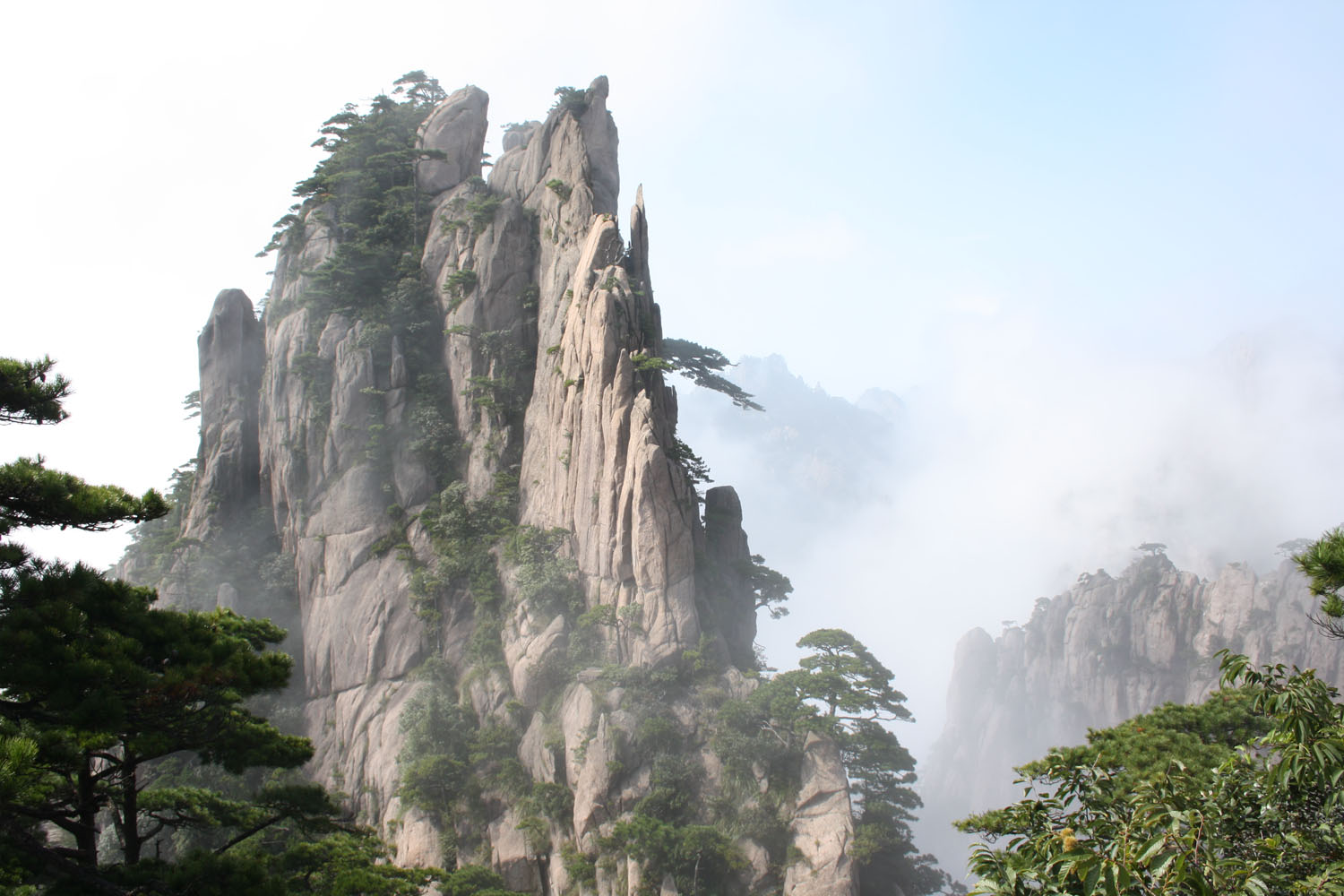 Mount Huangshan is widely celebrated. There are a large number of visitors each year. The authorities have taken measures to control wildfires by building fire brigades and water ponds. The unique geographical position of the site worsens the water scarcity, particularly during the dry season. This makes controlling forest fires, firefighting and vegetation conservation difficult (ACMHSS 2002). The pine resources of Mount Huangshan are threatened by natural and artificial scattering of pine wood. The authorities have taken action by creating bio-isolation regions and plant quarantine stations to monitor the pine wood nematode (ACMHSS 2002; IUCN Consultation 2017). Measures have also been taken to control and monitor pine wilt disease.
The statistics available in the Mount Huangshang World Heritage Monitoring Report indicate that the number of visitors to the site was 3.5 million in 2019 (IUCN Consultation 2020). The number of visitors is particularly high during holidays and festivals. This makes maintaining water quality and treatment of sewage difficulty. Tourism activities have caused other threats due to negligent activities such as smoking, which can cause forest fires and trampling of vegetation (ACMHSS 2002). The monitoring authorities responsible for the maintenance of Mount Huangshan World Heritage Site manage the sewage treatment facilities of the mountains. The management efforts have been successful in reducing generation of waste and minimizing secondary pollution. Sewage discharge is consolidated, and the impact of tourism is reduced by setting up “Scenic Site Green Development Bases”, promoting in-situ biological treatment, thus reducing the transportation of this waste and preventing secondary pollution, especially during long-term storage and long-distance transportation of waste (IUCN Consultation 2020). Lotus Peak, in the site, has been experiencing congestion. This has worsened due to the construction of three cable cars, which detract from the visitor experience during the peak holiday season (IUCN Consultation 2020; Mission Report 1998).
Increasing numbers of visitors are a potential threat. Sulphur dioxide is emitted from the industrialized province to the south of the site, and the area around Mount Huangshan is affected by acid rain (Wu et. al. 2015). Presently, the air quality is categorized as “Good”, but if the sulphur dioxide levels increase, there may be fatalities on account of the air quality (IUCN Consultation 2020).
The administrative committee of Huangshan executes a conservation and management plan to preserve the site’s scenic beauty. The site is divided into nine conservation zones, each having its own set of conservation regulations (IUCN Consultation 2017). Cultivation, livestock grazing, fuelwood gathering, hunting and industrial and mining activities are forbidden. Construction is prohibited within the buffer zone to avoid deterioraion of the quality of the landscape (UNEP-WCMC 2011). A master plan has been initiated. It aims to carry out conservation along with development and protect the scenic beauty. This scenic beauty is critical for sustainable development of the local community. The site is competently managed using the funds generated from the business run by the administrative unit and from ticket sales (ACMHSS 2002). The Mount Huanshan World Cultural and Natural Heritage Monitoring Centre was instituted with the Mount Huangshan World Heritage Monitoring Information System for better monitoring (IUCN Consultation 2020). Besides, focused research has been conducted to carry out efficient management (WCMC 2011).
Mount Huangshan is widely celebrated. There are a large number of visitors each year. The authorities have taken measures to control wildfires by building fire brigades and water ponds. The unique geographical position of the site worsens the water scarcity, particularly during the dry season. This makes controlling forest fires, firefighting and vegetation conservation difficult (ACMHSS 2002). The pine resources of Mount Huangshan are threatened by natural and artificial scattering of pine wood. The authorities have taken action by creating bio-isolation regions and plant quarantine stations to monitor the pine wood nematode (ACMHSS 2002; IUCN Consultation 2017). Measures have also been taken to control and monitor pine wilt disease.
The statistics available in the Mount Huangshang World Heritage Monitoring Report indicate that the number of visitors to the site was 3.5 million in 2019 (IUCN Consultation 2020). The number of visitors is particularly high during holidays and festivals. This makes maintaining water quality and treatment of sewage difficulty. Tourism activities have caused other threats due to negligent activities such as smoking, which can cause forest fires and trampling of vegetation (ACMHSS 2002). The monitoring authorities responsible for the maintenance of Mount Huangshan World Heritage Site manage the sewage treatment facilities of the mountains. The management efforts have been successful in reducing generation of waste and minimizing secondary pollution. Sewage discharge is consolidated, and the impact of tourism is reduced by setting up “Scenic Site Green Development Bases”, promoting in-situ biological treatment, thus reducing the transportation of this waste and preventing secondary pollution, especially during long-term storage and long-distance transportation of waste (IUCN Consultation 2020). Lotus Peak, in the site, has been experiencing congestion. This has worsened due to the construction of three cable cars, which detract from the visitor experience during the peak holiday season (IUCN Consultation 2020; Mission Report 1998).
Increasing numbers of visitors are a potential threat. Sulphur dioxide is emitted from the industrialized province to the south of the site, and the area around Mount Huangshan is affected by acid rain (Wu et. al. 2015). Presently, the air quality is categorized as “Good”, but if the sulphur dioxide levels increase, there may be fatalities on account of the air quality (IUCN Consultation 2020).
The administrative committee of Huangshan executes a conservation and management plan to preserve the site’s scenic beauty. The site is divided into nine conservation zones, each having its own set of conservation regulations (IUCN Consultation 2017). Cultivation, livestock grazing, fuelwood gathering, hunting and industrial and mining activities are forbidden. Construction is prohibited within the buffer zone to avoid deterioraion of the quality of the landscape (UNEP-WCMC 2011). A master plan has been initiated. It aims to carry out conservation along with development and protect the scenic beauty. This scenic beauty is critical for sustainable development of the local community. The site is competently managed using the funds generated from the business run by the administrative unit and from ticket sales (ACMHSS 2002). The Mount Huanshan World Cultural and Natural Heritage Monitoring Centre was instituted with the Mount Huangshan World Heritage Monitoring Information System for better monitoring (IUCN Consultation 2020). Besides, focused research has been conducted to carry out efficient management (WCMC 2011).

